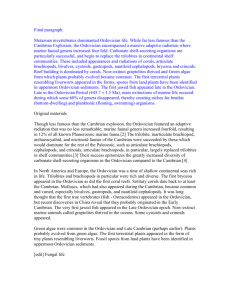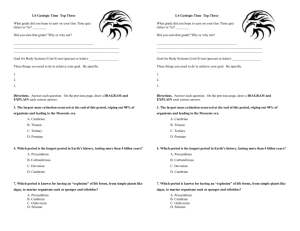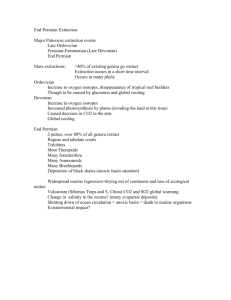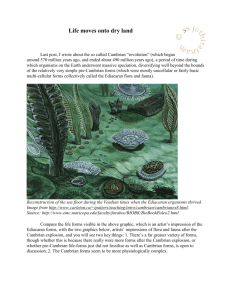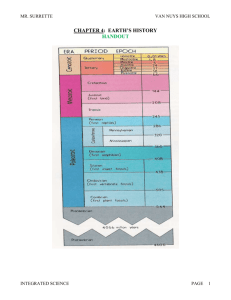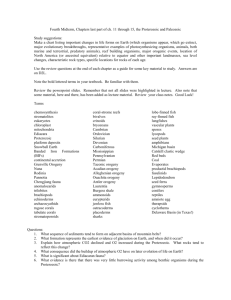The Ordovician: Life`s second big bang
advertisement
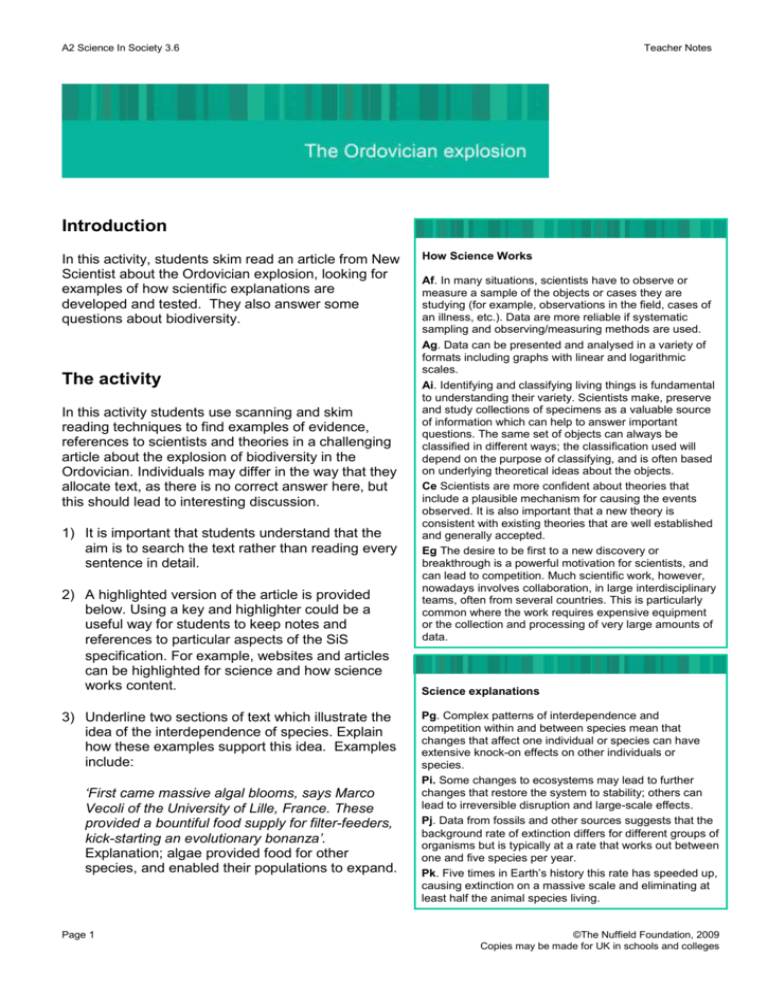
A2 Science In Society 3.6 Teacher Notes Introduction In this activity, students skim read an article from New Scientist about the Ordovician explosion, looking for examples of how scientific explanations are developed and tested. They also answer some questions about biodiversity. The activity In this activity students use scanning and skim reading techniques to find examples of evidence, references to scientists and theories in a challenging article about the explosion of biodiversity in the Ordovician. Individuals may differ in the way that they allocate text, as there is no correct answer here, but this should lead to interesting discussion. 1) It is important that students understand that the aim is to search the text rather than reading every sentence in detail. 2) A highlighted version of the article is provided below. Using a key and highlighter could be a useful way for students to keep notes and references to particular aspects of the SiS specification. For example, websites and articles can be highlighted for science and how science works content. 3) Underline two sections of text which illustrate the idea of the interdependence of species. Explain how these examples support this idea. Examples include: ‘First came massive algal blooms, says Marco Vecoli of the University of Lille, France. These provided a bountiful food supply for filter-feeders, kick-starting an evolutionary bonanza’. Explanation; algae provided food for other species, and enabled their populations to expand. Page 1 How Science Works Af. In many situations, scientists have to observe or measure a sample of the objects or cases they are studying (for example, observations in the field, cases of an illness, etc.). Data are more reliable if systematic sampling and observing/measuring methods are used. Ag. Data can be presented and analysed in a variety of formats including graphs with linear and logarithmic scales. Ai. Identifying and classifying living things is fundamental to understanding their variety. Scientists make, preserve and study collections of specimens as a valuable source of information which can help to answer important questions. The same set of objects can always be classified in different ways; the classification used will depend on the purpose of classifying, and is often based on underlying theoretical ideas about the objects. Ce Scientists are more confident about theories that include a plausible mechanism for causing the events observed. It is also important that a new theory is consistent with existing theories that are well established and generally accepted. Eg The desire to be first to a new discovery or breakthrough is a powerful motivation for scientists, and can lead to competition. Much scientific work, however, nowadays involves collaboration, in large interdisciplinary teams, often from several countries. This is particularly common where the work requires expensive equipment or the collection and processing of very large amounts of data. Science explanations Pg. Complex patterns of interdependence and competition within and between species mean that changes that affect one individual or species can have extensive knock-on effects on other individuals or species. Pi. Some changes to ecosystems may lead to further changes that restore the system to stability; others can lead to irreversible disruption and large-scale effects. Pj. Data from fossils and other sources suggests that the background rate of extinction differs for different groups of organisms but is typically at a rate that works out between one and five species per year. Pk. Five times in Earth’s history this rate has speeded up, causing extinction on a massive scale and eliminating at least half the animal species living. ©The Nuffield Foundation, 2009 Copies may be made for UK in schools and colleges A2 Science In Society 3.6 Teacher Notes ‘Diverse reef systems formed around stony sponges called archaeocyathids’. Explanation: stony sponges formed food and shelter for other species. ‘Burrowing animals went deeper than before, churning up the sea floor and creating new habitats’. Explanation: burrowing species altered the environment of the sea floor to the benefit of other species, which found new habitats. 4) (i) Describe what the graph (Figure xx) shows about the changes in fauna in the time period shown. The modern fauna show an overall increase in the period between 542 and 443 MYA, with a steep rise during the period of bombardment after 467 MYA and at the end of the Silurian. (ii) What does the article suggest are possible explanations for the rise in biodiversity during the Ordovician? Bombardment by meteorites for outer space causing destruction and change to the environment which created new habitats, increased volcanism and mountain building providing new environments, shallow seas rich in nutrients and light. 5) How could scientists further test the theory linking asteroids to an increase in biodiversity? More fossil evidence is needed to show a sudden increase in biodiversity in the same period as ancient impact craters shown by fossil meteorites and chromite. 6) Explain how this article illustrates the need for scientists to collaborate internationally. (i) The evidence described in 5) from different sites around the world could corroborate the theory of the role of asteroids in the Ordovician biodiversity explosion. (ii) The importance of classifying living organisms. Unless scientists agree about the identification of living and fossil organisms, the changes over time, and in different parts of the world can’t be monitored. 7) Find one example of where a scientist has explained a possible mechanism for an observed event. Marco Vecoli explains how a burst of biodiversity could follow a barren period: By 510 million years ago, the number of genera had dropped to 450 from a peak of about 600. "The middle to late Cambrian is almost like an empty quarter. There is a surprising amount of barrenness," says Arnie Miller, a palaeobiologist at the University of Cincinnati in Ohio. Then, at the start of the Ordovician period, 489 million years ago, evolution sparked back into life. First came massive algal blooms, says Marco Vecoli of the University of Lille, France. These provided a bountiful food supply for filter-feeders, kick-starting an evolutionary bonanza. The stromatolites were booted out once more, with sponges re-establishing themselves as major reefbuilding organisms. They were joined by coral species as reefs again became hotspots of biodiversity Page 2 ©The Nuffield Foundation, 2009 Copies may be made for UK in schools and colleges A2 Science In Society 3.6 Teacher Notes The Ordovician: Life's second big bang This article has been used with permission from the copyright holders - New Scientist, www.NewScientist.com 11 June 2008 by James O'Donoghue Magazine issue 2660 Key References to scientists’ work which suggests theories explaining the explosion of biodiversity in the Ordovician period. Specific examples of evidence which supports a theory explained in the article. Examples of theories presented as if they are widely accepted by the scientific community. Theories which are still in the process of being considered by the scientific community. Just over half a billion years ago, evolution hit a purple patch. In the space of a few million years, onceempty seas were suddenly overrun by all manner of newfangled life forms. Animals had arrived on the scene and life on Earth never looked back. At least, that's what we originally thought the fossil record was telling us. It now turns out that this spectacular event - known as the Cambrian explosion - stuttered to a halt not long after it began. Around 515 million years ago, evolution ran out of steam and the increase in biodiversity went into reverse. For the march of progress to continue, life needed rebooting. It came in the form of a second explosion of life called the Great Ordovician Biodiversification Event, a little-heard-of episode which has been the focus of intense scientific interest in recent years. Since discovering hints of it around 20 years ago, palaeontologists have established beyond doubt that the "Ordovician explosion" was every bit as momentous for animal evolution as the Cambrian one. Now they are asking a more difficult question: what caused it? The Cambrian period, from 542 to 489 million years ago, has always exerted an irresistible lure for palaeontologists. For thousands of millions of years before it, the most complex life forms on Earth were marine microbial mats known as stromatolites. These were briefly superseded by the enigmatic Ediacarans, the first large-bodied life forms on Earth (New Scientist, 14 April 2007, p 34). Then, in the space of just 20 million years at the start of the Cambrian, all bar one of the basic types, or phyla, of animals we see around us today, made their appearance in the fossil record. Stromatolites became lunch and faded away as trilobites and other arthropods came to dominate the seas. High levels of dissolved nutrients supported filter-feeders such as sponges, molluscs, echinoderms and clam-like brachiopods. Diverse reef systems formed around stony sponges called archaeocyathids. But this watery Eden wasn't to last. The fossil record reveals a decline in biodiversity by the middle of the Cambrian, one so steep that in the early 1990s Phil Signor of the University of California, Davis, suggested there had been a mass extinction starting around 515 million years ago (New Scientist, 1 August 1992, p 14). It later became clear that the decline in biodiversity was not a mass extinction but resulted from a sharp drop in origination - the rate at which new species appear. According to a 2004 paper by Richard Bambach and Andrew Knoll of Harvard University, by the mid-Cambrian the origination rate in many groups had fallen to between a fifth and a third of the levels seen earlier, well below the natural rate at Page 3 ©The Nuffield Foundation, 2009 Copies may be made for UK in schools and colleges A2 Science In Society 3.6 Teacher Notes which species were becoming extinct. It's not clear why this happened, but the result was a decline in biodiversity (Paleobiology, vol 30, p 522). Many major groups were hit hard, while the archaeocyathids disappeared altogether and were replaced by stromatolites. Cambrian life had gone from explosion to damp squib. By 510 million years ago, the number of genera had dropped to 450 from a peak of about 600. "The middle to late Cambrian is almost like an empty quarter. There is a surprising amount of barrenness," says Arnie Miller, a palaeobiologist at the University of Cincinnati in Ohio. Then, at the start of the Ordovician period, 489 million years ago, evolution sparked back into life. First came massive algal blooms, says Marco Vecoli of the University of Lille, France. These provided a bountiful food supply for filter-feeders, kick-starting an evolutionary bonanza. The stromatolites were booted out once more, with sponges re-establishing themselves as major reef-building organisms. They were joined by coral species as reefs again became hotspots of biodiversity (see "Life in the Ordovician seas"). The evolutionary tempo picked up and new animal species began to appear as never before. Though only one new phylum appeared during the Ordovician - the moss animals or bryozoans - diversity within existing phyla rocketed, quickly outstripping anything achieved in the Cambrian. "During the Cambrian there is a fantastic array of new body plans, but it wasn't until the early to mid-Ordovician that we got a really striking increase in diversity," says Dave Harper of the University of Copenhagen in Denmark. By the end of the Ordovician, biodiversity had reached a level that would not be surpassed for another 200 million years. Look along the shoreline today and chances are you will find creatures that first appeared in the Ordovician, including starfish, sea urchins, oysters and scallops. The Ordovician also saw an increase in ecological complexity. During the Cambrian, animals had largely been confined to the sea floor. There may have been a few worms poking around in the mud and the odd animal in the water immediately above, but the real action was on the sediment itself. That largely twodimensional world was fundamentally altered by the Ordovician newcomers. Burrowing animals went deeper than before, churning up the sea floor and creating new habitats. "You are pushing more and more species into the same space, and they are having to start to do things in a different way," says Harper. "One of the ways is to dig deeper and deeper, but they are also building higher and higher tiers [of reefs] above the sediment." As competition increased, more ingenuity was required to survive. Whereas filter-feeders once sat back and waited for food to arrive on the currents, they were now having to actively filter the water for nutrients. "Wow, there's a whole new food source, and this group takes advantage," says Mary Droser, a palaeobiologist at the University of California, Riverside. Another way to survive was to escape the sea floor altogether. A recent study by Kevin Peterson of Dartmouth College, New Hampshire, found that by the mid-Ordovician the larvae of several different animal groups had developed the ability to swim away from the sea bottom. This may have been driven by the need to dodge the swaying tentacles of the filter-feeders (Geology, vol 33, p 929). Life also staked its first claim on land. Simple plants colonised damp areas while scorpion-like eurypterids took their first tentative steps along the shoreline. This boom was like nothing the world has seen since. The Ordovician is the only time in the history of animal life that huge numbers of new species appeared without a mass extinction to clear the decks beforehand. "It's a real enigma in the history of life, and from my perspective it's unique," says Droser. So what triggered it? "There isn't a simple, sexy explanation," she adds. One possibility is that there was no evolutionary need to clear the decks: the stalled Cambrian explosion had left plenty of ecological space to be filled. Page 4 ©The Nuffield Foundation, 2009 Copies may be made for UK in schools and colleges A2 Science In Society 3.6 Teacher Notes It's certainly clear that environmental and geological conditions during the Ordovician were especially suited to biodiversification, says Alan Owen of the University of Glasgow in the UK, one of the leaders of a team trying to pin down the causes of the Ordovician explosion. "It was a time when the Earth's continents were widely dispersed and of extreme provincialism," he says (see Maps). "The seas around each continent had their own fauna. It was a time of mountain-building, which generated uplift, erosion and the introduction of nutrients into the sea. It was also a time of intense volcanic activity which generated yet more nutrients and created local environments where things could evolve." The surge in biodiversity also coincided with a warm, stable climate. On top of that, sea levels were some of the highest the world has ever seen, covering continental shelves with great expanses of warm, shallow water that provided light, oxygen and nutrients for life to thrive in. "There are no modern analogues for these very big, broad, shallow water areas," says Miller. "That sort of sea does not really exist now." These general environmental triggers are reasonably well accepted. But Birger Schmitz, a geologist at the University of Lund in Sweden, goes further, suggesting that there could indeed be a simple, sexy explanation for the diversity boom: the Ordovician explosion may have been triggered from space. Asteroid impacts are usually seen as the harbingers of doom, bringing death and destruction. Not so for Schmitz. He argues that colossal impacts during the Ordovician created the conditions for biodiversification, and believes he has evidence to prove it (Nature Geoscience, vol 1, p 49). The story begins 470 million years ago, when a large asteroid broke up in the solar system, creating a swarm of smaller asteroids and meteoroids (Meteoritics & Planetary Science, vol 42, p 113). Most of the fragments are still out there and, even now, they make up the majority of meteorites which fall to Earth. "If you are going to be hit by a meteorite, the probability is it will have an age of 470 million years," says Schmitz. The only confirmed case of a human being hit by a meteorite was when a young boy was struck by a fragment of this asteroid in Uganda in 1992. Luckily it didn't do him any harm. The same probably could not be said of Earth in the period immediately after the asteroid break-up. In 1988, Jan Nyström of the Swedish Museum Of Natural History in Stockholm announced a rare find - a fossil meteorite embedded in a slab of mid-Ordovician limestone from the Österplana quarry in Kinnekulle nature reserve, Sweden (Nature, vol 336, p 572). Since then, around 50 beautifully preserved fossil meteorites have been found in the area (Earth and Planetary Science Letters, vol 194, p 1). Recent dating studies show that these crash-landed into the Ordovician sea 467 million years ago, where they came to rest on the sediment and were fossilised alongside Ordovician creatures. Fossil meteorites are very rare - in fact more than 95 per cent of them originate from Kinnekulle - but ancient impacts leave other traces which can be detected in sedimentary rocks, in the form of grains of the mineral chromite found in extraterrestrial material. Schmitz uncovered this in abundance in midOrdovician strata throughout Sweden (Science, vol 300, p 961) and also in China, then - as now several thousand kilometres away. Based on the abundance of fossil meteorites and chromite in mid-Ordovician rocks, Schmitz concluded that the rate of impacts was around 100 times what it is today. And if meteorites were raining in thick and fast, enormous, destructive asteroids could not have been far behind, he says. This theory is backed up by the relative abundance of Ordovician impact craters among the 170 or so known craters on Earth, which suggests that large impacts were more common by a factor of 5 to 10 during the Middle Ordovician than at any other time in the past 540 million years. Page 5 ©The Nuffield Foundation, 2009 Copies may be made for UK in schools and colleges A2 Science In Society 3.6 Teacher Notes Could this be linked to the biological events that were unfolding at the time? Both Schmitz and Harper think so. Between 2000 and 2002, Harper and his team compiled a detailed record of fossil brachiopods - the most abundant and diverse animals of the Ordovician - in western Russia, Sweden, Norway and Estonia, all part of the region geologists call Balto-Scandinavia. This revealed a sudden rise in biodiversity around 467 million years ago, just as the area was being bombarded. "It matches the asteroid data more or less precisely," says Harper. Schmitz now believes that the destruction wrought by asteroids might have created the right conditions for diversification. He speculates that in the early Ordovician, the occupants of the sea were both widely dispersed and generalists, unspecialised in their ecological preferences. The asteroid impacts would have caused localised extinctions and thus created lots of vacant ecological niches for life to evolve into. Palaeontologists have given Schmitz's idea a cautious welcome. "It's an intriguing idea and a lot more could be done to test it," says Miller. Lots more is being done - the trick now is to replicate the findings elsewhere. So far, Schmitz only has evidence of a link between impacts and diversification from one region, Balto-Scandinavia, and only in one group, the brachiopods. The Chinese chromite shows increased meteorite flux, but so far there isn't any fossil evidence to go with it. The great biodiversification event was not to last indefinitely. The climate, for so long warm and conducive to life, became more erratic in the late Ordovician. A short-lived ice age marked the beginning of the end. There was a one-two extinction punch: the cold brought major changes to ocean circulation which killed off many animals, and when all the ice melted the oceans were flooded with poorly oxygenated water. The mass extinction at the end of the Ordovician period, 443 million years ago, was one of the most devastating ever to hit the planet. Fortunately, all was not lost. The arrival of so many new species and specialised ecosystems was not to be undone lightly. Life was now in much better shape to weather an extinction storm and bounced back fairly quickly. Diversity and complexity in the living world have stayed with us, the legacy of that longignored primeval boom. Evolution - Learn more about the struggle to survive in our comprehensive special report. Life in the Ordovician seas Marine fauna thrived in the long, hot summer that was the Ordovician period. Most abundant were brachiopods - shelled creatures vaguely resembling clams - together with bushy colonies of bryozoans covering the sea floor. There were also flowery crinoids, sea urchins, corals, sponges, clams and snails. Planktonic graptolites, shaped like letters from a defunct alphabet, drifted in the water. The stars of the show, though, were the trilobites and the shelled cephalopods. Most trilobites were just a few centimetres in size but one predatory species, Isotelus rex, grew up to 70 centimetres long, well over half as big again as the next-largest trilobite (Journal of Paleontology, vol 77, p 99). There was also a tremendous diversity of cephalopods in all shapes and sizes: tightly or loosely coiled and straight or curly-shelled. Many of these creatures were highly mobile and formidable predators at the top of the food chain. Cameroceras, measuring up to 5 metres long, is among the largest invertebrates ever to have lived. James O'Donoghue is a writer based in the UK June 2009 Page 6 ©The Nuffield Foundation, 2009 Copies may be made for UK in schools and colleges A2 Science In Society 3.6 Student sheets Introduction This article is about an explosion of biodiversity over 400 million years ago in the Ordovician period. In the activity, you will use skim reading techniques to find examples of evidence and references to scientists’ work. The story provides good examples of how scientific explanations are developed and tested, (HSW C). You do not need to know the detailed biology in this challenging article, the aim is to practice scanning for the information you need. 1) Use skim reading techniques to get an overview of the article ‘The Ordovician: Life's second big bang’. 2) Use different colours to highlight the following as you read. You can do this electronically, or on a hard copy of the article: Scientists suggesting theories References to scientists who are suggesting theories explaining the explosion of biodiversity in the Ordovician period. For example: ‘First came massive algal blooms, says Marco Vecoli of the University of Lille, France’. Evidence Specific examples of evidence which supports a theory explained in the article. For example: ‘The fossil record reveals a decline in biodiversity by the middle of the Cambrian’. Widely accepted theories Two examples of theories presented as if they are widely accepted by the scientific community. New theories Two examples of theories which are still in the process of being considered by the scientific community. 3) Underline two sections of text which illustrate the idea of the interdependence of species. Explain how these examples support this idea. 4) (i) Describe what the graph (Figure 1) shows about the changes in fauna in the time period shown. (ii) What does the article suggest are possible explanations for the rise in biodiversity during the Ordovician? 5) How could scientists further test the theory linking asteroids to an increase in biodiversity? 6) Explain how this article illustrates i) The need for scientists to collaborate internationally. ii) The importance of classifying living organisms. 7) Find one example of where a scientist has explained a possible mechanism for an observed event. Page 1 ©The Nuffield Foundation, 2009 Copies may be made for UK in schools and colleges A2 Science In Society 3.6 Student sheets The Ordovician: Life's second big bang This article has been used with permission from the copyright holders - New Scientist, www.NewScientist.com Abstract At the start of the Cambrian, in the space of 20 million years, all except one of the animal phyla present today made their first appearance. Seas which had been relatively barren exploded into life. But, this sudden increase in biodiversity stopped and then reversed by the middle Cambrian. The rate at which new species were appearing did not keep pace with the natural rate of extinction, so the second half of the Cambrian is surprisingly barren. The following, Ordovician, period saw biodiversity suddenly pick up again, with new species appearing at an unprecedented rate. Although the main body plans of the different animal phyla evolved in the Cambrian, the Ordovician saw the development of a rich diversity of species; variations on the main animal groups. Explanations of the Ordovician explosion are still discussed by scientists. These include a link between the surge in biodiversity and climate change, an increase in the range of available habitats and the effects of asteroid collisions. 11 June 2008 by James O'Donoghue Magazine issue 2660 Just over half a billion years ago, evolution hit a purple patch. In the space of a few million years, once-empty seas were suddenly overrun by all manner of newfangled life forms. Animals had arrived on the scene and life on Earth never looked back. At least, that's what we originally thought the fossil record was telling us. It now turns out that this spectacular event - known as the Cambrian explosion - stuttered to a halt not long after it began. Around 515 million years ago, evolution ran out of steam and the increase in biodiversity went into reverse. For the march of progress to continue, life needed rebooting. It came in the form of a second explosion of life called the Great Ordovician Biodiversification Event, a little-heard-of episode which has been the focus of intense scientific interest in recent years. Since discovering hints of it around 20 years ago, palaeontologists have established beyond doubt that the "Ordovician explosion" was every bit as momentous for animal evolution as the Cambrian one. Now they are asking a more difficult question: what caused it? The Cambrian period, from 542 to 489 million years ago, has always exerted an irresistible lure for palaeontologists. For thousands of millions of years before it, the most complex life forms on Earth were marine microbial mats known as stromatolites. These were briefly superseded by the enigmatic Ediacarans, the first large-bodied life forms on Earth. Then, in the space of just 20 million years at the start of the Cambrian, all bar one of the basic types, or phyla, of animals we see around us today, made their appearance in the fossil record. Stromatolites became lunch and faded away as trilobites and other arthropods came to dominate the seas. High levels of dissolved nutrients supported filter-feeders such as sponges, molluscs, echinoderms and clam-like brachiopods. Diverse reef systems formed around stony sponges called archaeocyathids. Page 2 ©The Nuffield Foundation, 2009 Copies may be made for UK in schools and colleges A2 Science In Society 3.6 Student sheets But this watery Eden wasn't to last. The fossil record reveals a decline in biodiversity by the middle of the Cambrian, one so steep that in the early 1990s Phil Signor of the University of California, Davis, suggested there had been a mass extinction starting around 515 million years ago. It later became clear that the decline in biodiversity was not a mass extinction but resulted from a sharp drop in origination - the rate at which new species appear. According to a 2004 paper by Richard Bambach and Andrew Knoll of Harvard University, by the mid-Cambrian the origination rate in many groups had fallen to between a fifth and a third of the levels seen earlier, well below the natural rate at which species were becoming extinct. It's not clear why this happened, but the result was a decline in biodiversity. Many major groups were hit hard, while the archaeocyathids disappeared altogether and were replaced by stromatolites. Cambrian life had gone from explosion to damp squib. By 510 million years ago, the number of genera had dropped to 450 from a peak of about 600. "The middle to late Cambrian is almost like an empty quarter. There is a surprising amount of barrenness," says Arnie Miller, a palaeobiologist at the University of Cincinnati in Ohio. Then, at the start of the Ordovician period, 489 million years ago, evolution sparked back into life. First came massive algal blooms, says Marco Vecoli of the University of Lille, France. These provided a bountiful food supply for filter-feeders, kick-starting an evolutionary bonanza. The stromatolites were booted out once more, with sponges re-establishing themselves as major reefbuilding organisms. They were joined by coral species as reefs again became hotspots of biodiversity. The evolutionary tempo picked up and new animal species began to appear as never before. Though only one new phylum appeared during the Ordovician - the moss animals or bryozoans diversity within existing phyla rocketed, quickly outstripping anything achieved in the Cambrian. "During the Cambrian there is a fantastic array of new body plans, but it wasn't until the early to mid-Ordovician that we got a really striking increase in diversity," says Dave Harper of the University of Copenhagen in Denmark. By the end of the Ordovician, biodiversity had reached a level that would not be surpassed for another 200 million years. Look along the shoreline today and chances are you will find creatures that first appeared in the Ordovician, including starfish, sea urchins, oysters and scallops. The Ordovician also saw an increase in ecological complexity. During the Cambrian, animals had largely been confined to the sea floor. There may have been a few worms poking around in the mud and the odd animal in the water immediately above, but the real action was on the sediment itself. That largely two-dimensional world was fundamentally altered by the Ordovician newcomers. Burrowing animals went deeper than before, churning up the sea floor and creating new habitats. "You are pushing more and more species into the same space, and they are having to start to do things in a different way," says Harper. "One of the ways is to dig deeper and deeper, but they are also building higher and higher tiers [of reefs] above the sediment." As competition increased, more ingenuity was required to survive. Whereas filter-feeders once sat back and waited for food to arrive on the currents, they were now having to actively filter the water for nutrients. "Wow, there's a whole new food source, and this group takes advantage," says Mary Droser, a palaeobiologist at the University of California, Riverside. Another way to survive was to escape the sea floor altogether. A recent study by Kevin Peterson of Dartmouth College, New Hampshire, found that by the mid-Ordovician the larvae of several different animal groups had developed the ability to swim away from the sea bottom. This may have been driven by the need to dodge the swaying tentacles of the filter-feeders. Page 3 ©The Nuffield Foundation, 2009 Copies may be made for UK in schools and colleges A2 Science In Society 3.6 Student sheets Life also staked its first claim on land. Simple plants colonised damp areas while scorpion-like eurypterids took their first tentative steps along the shoreline. This boom was like nothing the world has seen since. The Ordovician is the only time in the history of animal life that huge numbers of new species appeared without a mass extinction to clear the decks beforehand. "It's a real enigma in the history of life, and from my perspective it's unique," says Droser. So what triggered it? "There isn't a simple, sexy explanation," she adds. One possibility is that there was no evolutionary need to clear the decks: the stalled Cambrian explosion had left plenty of ecological space to be filled. It's certainly clear that environmental and geological conditions during the Ordovician were especially suited to biodiversification, says Alan Owen of the University of Glasgow in the UK, one of the leaders of a team trying to pin down the causes of the Ordovician explosion. "It was a time when the Earth's continents were widely dispersed and of extreme provincialism," he says (see Maps). "The seas around each continent had their own fauna. It was a time of mountain-building, which generated uplift, erosion and the introduction of nutrients into the sea. It was also a time of intense volcanic activity which generated yet more nutrients and created local environments where things could evolve." The surge in biodiversity also coincided with a warm, stable climate. On top of that, sea levels were some of the highest the world has ever seen, covering continental shelves with great expanses of warm, shallow water that provided light, oxygen and nutrients for life to thrive in. "There are no modern analogues for these very big, broad, shallow water areas," says Miller. "That sort of sea does not really exist now." These general environmental triggers are reasonably well accepted. But Birger Schmitz, a geologist at the University of Lund in Sweden, goes further, suggesting that there could indeed be a simple, sexy explanation for the diversity boom: the Ordovician explosion may have been triggered from space. Asteroid impacts are usually seen as the harbingers of doom, bringing death and destruction. Not so for Schmitz. He argues that colossal impacts during the Ordovician created the conditions for biodiversification, and believes he has evidence to prove it. The story begins 470 million years ago, when a large asteroid broke up in the solar system, creating a swarm of smaller asteroids and meteoroids. Most of the fragments are still out there and, even now, they make up the majority of meteorites which fall to Earth. "If you are going to be hit by a meteorite, the probability is it will have an age of 470 million years," says Schmitz. The only confirmed case of a human being hit by a meteorite was when a young boy was struck by a fragment of this asteroid in Uganda in 1992. Luckily it didn't do him any harm. The same probably could not be said of Earth in the period immediately after the asteroid break-up. In 1988, Jan Nyström of the Swedish Museum Of Natural History in Stockholm announced a rare find - a fossil meteorite embedded in a slab of mid-Ordovician limestone from the Österplana quarry in Kinnekulle nature reserve, Sweden. Since then, around 50 beautifully preserved fossil meteorites have been found in the area. Recent dating studies show that these crash-landed into the Ordovician sea 467 million years ago, where they came to rest on the sediment and were fossilised alongside Ordovician creatures. Page 4 ©The Nuffield Foundation, 2009 Copies may be made for UK in schools and colleges A2 Science In Society 3.6 Student sheets Fossil meteorites are very rare - in fact more than 95 per cent of them originate from Kinnekulle but ancient impacts leave other traces which can be detected in sedimentary rocks, in the form of grains of the mineral chromite found in extraterrestrial material. Schmitz uncovered this in abundance in mid-Ordovician strata throughout Sweden and also in China, then - as now - several thousand kilometres away. Based on the abundance of fossil meteorites and chromite in mid-Ordovician rocks, Schmitz concluded that the rate of impacts was around 100 times what it is today. And if meteorites were raining in thick and fast, enormous, destructive asteroids could not have been far behind, he says. This theory is backed up by the relative abundance of Ordovician impact craters among the 170 or so known craters on Earth, which suggests that large impacts were more common by a factor of 5 to 10 during the Middle Ordovician than at any other time in the past 540 million years. Could this be linked to the biological events that were unfolding at the time? Both Schmitz and Harper think so. Between 2000 and 2002, Harper and his team compiled a detailed record of fossil brachiopods - the most abundant and diverse animals of the Ordovician - in western Russia, Sweden, Norway and Estonia, all part of the region geologists call Balto-Scandinavia. This revealed a sudden rise in biodiversity around 467 million years ago, just as the area was being bombarded. "It matches the asteroid data more or less precisely," says Harper. Schmitz now believes that the destruction wrought by asteroids might have created the right conditions for diversification. He speculates that in the early Ordovician, the occupants of the sea were both widely dispersed and generalists, unspecialised in their ecological preferences. The asteroid impacts would have caused localised extinctions and thus created lots of vacant ecological niches for life to evolve into. Palaeontologists have given Schmitz's idea a cautious welcome. "It's an intriguing idea and a lot more could be done to test it," says Miller. Lots more is being done - the trick now is to replicate the findings elsewhere. So far, Schmitz only has evidence of a link between impacts and diversification from one region, Balto-Scandinavia, and only in one group, the brachiopods. The Chinese chromite shows increased meteorite flux, but so far there isn't any fossil evidence to go with it. The great biodiversification event was not to last indefinitely. The climate, for so long warm and conducive to life, became more erratic in the late Ordovician. A short-lived ice age marked the beginning of the end. There was a one-two extinction punch: the cold brought major changes to ocean circulation which killed off many animals, and when all the ice melted the oceans were flooded with poorly oxygenated water. The mass extinction at the end of the Ordovician period, 443 million years ago, was one of the most devastating ever to hit the planet. Fortunately, all was not lost. The arrival of so many new species and specialised ecosystems was not to be undone lightly. Life was now in much better shape to weather an extinction storm and bounced back fairly quickly. Diversity and complexity in the living world have stayed with us, the legacy of that long-ignored primeval boom. Evolution - Learn more about the struggle to survive in our comprehensive special report. Life in the Ordovician seas Marine fauna thrived in the long, hot summer that was the Ordovician period. Most abundant were brachiopods - shelled creatures vaguely resembling clams - together with bushy colonies of bryozoans covering the sea floor. There were also flowery crinoids, sea urchins, corals, sponges, clams and snails. Planktonic graptolites, shaped like letters from a defunct alphabet, drifted in the water. Page 5 ©The Nuffield Foundation, 2009 Copies may be made for UK in schools and colleges A2 Science In Society 3.6 Student sheets The stars of the show, though, were the trilobites and the shelled cephalopods. Most trilobites were just a few centimetres in size but one predatory species, Isotelus rex, grew up to 70 centimetres long, well over half as big again as the next-largest trilobite. There was also a tremendous diversity of cephalopods in all shapes and sizes: tightly or loosely coiled and straight or curly-shelled. Many of these creatures were highly mobile and formidable predators at the top of the food chain. Cameroceras, measuring up to 5 metres long, is among the largest invertebrates ever to have lived. Figure 1 James O'Donoghue is a writer based in the UK Page 6 ©The Nuffield Foundation, 2009 Copies may be made for UK in schools and colleges
